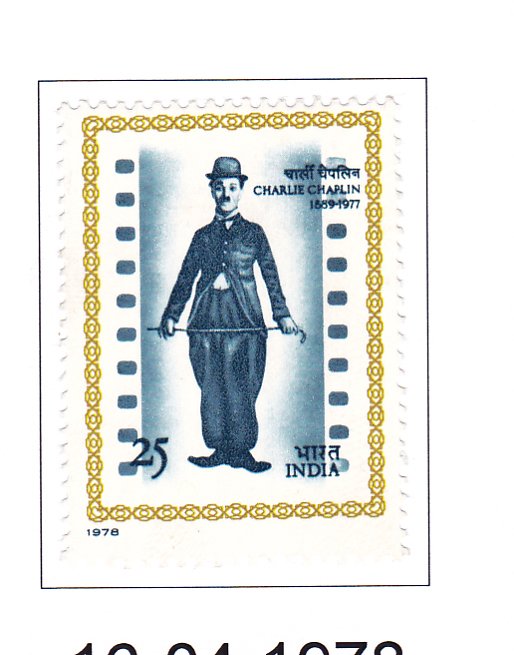Charlie Chaplin (1889-1977) Commemoration

Technical Data
| Date of Issue | April 16, 1978 |
|---|---|
| Denomination | 25 p |
| Quantity | 3,000,000 |
| Perforation | comb 13½ |
| Printer | Security Printing Press, Nashik |
| Watermark | No Watermark |
| Colors | Multicolor |
| Catalog Codes |
Michel IN 760 Stamp Number IN 797 Yvert et Tellier IN 557 Stanley Gibbons IN 887 |
| Themes | Actors | Authors | Commemoration | Famous people | Headgear | Literary People (Poets and Writers) | Literature | Men |
Charles Spencer Chaplin’s unique and inimitable style of comedy made him one of the most celebrated figures in entertainment history. Born in London on April 16, 1889, Charlie Chaplin faced a difficult childhood as the son of an alcoholic vaudevillian who provided sporadic support to his estranged wife and children. His mother’s mental breakdown due to poverty led Chaplin, at six years old, to endure the harsh reality of workhouses and schools for destitute children. These experiences instilled in him a deep understanding of poverty and a strong social consciousness, which became evident in his best films.
Chaplin began performing at an early age with the Eight Lancashire Lads, a clog-dancing group, and later took on small comic roles on the London stage. He eventually joined the celebrated Karno troupe and, by the age of 21, became a music-hall star. In 1913, he started working at Keystone Studios for $150 a week. His iconic character, developed through baggy pants, an undersized coat, and oversized shoes, was completed with a moustache to conceal his youth. Chaplin later explained, “I had no idea of the character. But the moment I was dressed, the clothes and the make-up made me feel the person he was. I began to know him and by the time I walked on to the stage, he was fully born.”
Some of Chaplin’s most notable films include “The Tramp” (1915), “Shoulder Arms” (1918), “The Kid” (1921), and “Gold Rush” (1925). In “Modern Times” (1936), he reached his peak, depicting the struggle against a huge, mindless factory machine. “The Great Dictator” (1940) boldly ridiculed Hitler before America entered World War II. Post-war films like “Monsieur Verdoux” (1947), “Limelight” (1952), and “A King in New York” (1957) continued his legacy. At 76, Chaplin returned to direct “A Countess from Hong Kong” (1967), starring Sophia Loren and Marlon Brando.
In 1972, Hollywood finally recognized Chaplin’s immense contribution to cinema by awarding him an honorary Oscar, citing “the incalculable effect he has had in making motion pictures the art form of this century.” In 1975, he was knighted by Queen Elizabeth II. Chaplin’s death on Christmas Day, 1977, was peaceful and calm, as described by his physician, mirroring the serene exits of his on-screen character, the Little Tramp.
The Indian Postal and Telegraph Departments feel privileged to issue a commemorative stamp in honor of Charlie Chaplin—an international personality.
